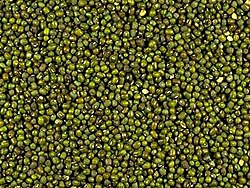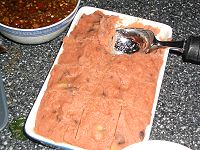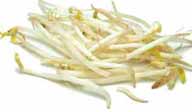Mung bean: Difference between revisions
correction of nutritional facts according to http://www.nal.usda.gov/fnic/foodcomp/cgi-bin/list_nut_edit.pl |
Skumarlabot (talk | contribs) m Robot-assisted disambiguation: Tamil |
||
| Line 16: | Line 16: | ||
| synonyms = ''Phaseolus aureus'' <small>Roxb.</small> |
| synonyms = ''Phaseolus aureus'' <small>Roxb.</small> |
||
}} |
}} |
||
'''Mung bean''', also known as '''mung''', '''moong''', '''mash bean''', '''munggo''' or '''monggo''', '''green gram''', '''golden gram''', and '''green soy''', is the seed of ''Vigna radiata'' which is native to [[India]]. The split bean is known as '''moong [[dal]]''', which is green with the husk, and yellow when dehusked. The beans are small, ovoid in shape, and green in color. The English word "mung" derives from the [[Hindi]] ''moong''. It is also known by the names ''hesaru bele'' ([[Kannada]]), ''moog'' ([[Marathi]]), ''payiru'' ([[Tamil]]), ''pesalu'' ([[Telugu]]). In the [[Philippines]], it is called ''munggo'' or ''monggo''. |
'''Mung bean''', also known as '''mung''', '''moong''', '''mash bean''', '''munggo''' or '''monggo''', '''green gram''', '''golden gram''', and '''green soy''', is the seed of ''Vigna radiata'' which is native to [[India]]. The split bean is known as '''moong [[dal]]''', which is green with the husk, and yellow when dehusked. The beans are small, ovoid in shape, and green in color. The English word "mung" derives from the [[Hindi]] ''moong''. It is also known by the names ''hesaru bele'' ([[Kannada]]), ''moog'' ([[Marathi]]), ''payiru'' ([[Tamil language|Tamil]]), ''pesalu'' ([[Telugu]]). In the [[Philippines]], it is called ''munggo'' or ''monggo''. |
||
The mung bean is one of many species recently moved from the [[genus]] ''[[Phaseolus]]'' to ''[[Vigna]]'' and is still often seen cited as ''Phaseolus aureus'' or ''Phaseolus radiatus''. These are all the same plant. |
The mung bean is one of many species recently moved from the [[genus]] ''[[Phaseolus]]'' to ''[[Vigna]]'' and is still often seen cited as ''Phaseolus aureus'' or ''Phaseolus radiatus''. These are all the same plant. |
||
Revision as of 04:31, 23 February 2008
| Mung bean | |
|---|---|

| |
| Scientific classification | |
| Kingdom: | |
| Division: | |
| Class: | |
| Order: | |
| Family: | |
| Genus: | |
| Species: | V. radiata
|
| Binomial name | |
| Vigna radiata (L.) R. Wilczek
| |
| Synonyms | |
|
Phaseolus aureus Roxb. | |
Mung bean, also known as mung, moong, mash bean, munggo or monggo, green gram, golden gram, and green soy, is the seed of Vigna radiata which is native to India. The split bean is known as moong dal, which is green with the husk, and yellow when dehusked. The beans are small, ovoid in shape, and green in color. The English word "mung" derives from the Hindi moong. It is also known by the names hesaru bele (Kannada), moog (Marathi), payiru (Tamil), pesalu (Telugu). In the Philippines, it is called munggo or monggo.
The mung bean is one of many species recently moved from the genus Phaseolus to Vigna and is still often seen cited as Phaseolus aureus or Phaseolus radiatus. These are all the same plant.
| Nutritional value per 100 g (3.5 oz) | |||||||||||||||||||||||||
|---|---|---|---|---|---|---|---|---|---|---|---|---|---|---|---|---|---|---|---|---|---|---|---|---|---|
| Energy | 441 kJ (105 kcal) | ||||||||||||||||||||||||
19.15 g | |||||||||||||||||||||||||
| Sugars | 2.00 g | ||||||||||||||||||||||||
| Dietary fiber | 7.6 g | ||||||||||||||||||||||||
0.38 g | |||||||||||||||||||||||||
7.02 g | |||||||||||||||||||||||||
| |||||||||||||||||||||||||
| †Percentages estimated using US recommendations for adults,[1] except for potassium, which is estimated based on expert recommendation from the National Academies.[2] | |||||||||||||||||||||||||
Climate and soil
Mung beans are mainly cultivated in India, Indonesia, China, Burma and Bangladesh. In India and Bangladesh, they are grown during two seasons. One is the Rabi season (starting November), and the other is the Kharif season (starting March). Mung beans are tropical (or sub-tropical) crops, and require warm temperatures (optimal at 30-35°C). Loamy soil is best for mung bean cultivation.
Uses
Mung beans are commonly used in Chinese cuisine, where they are called lǜ dòu (绿豆, literally "green bean"), as well as in Japan, Korea, India, Thailand and Southeast Asia. In Vietnam, they are called đậu xanh (again, literally "green bean"). They are generally eaten either whole (with or without skins) or as bean sprouts, or used to make the dessert "green bean soup". The starch of mung beans is also separated from the ground beans to make jellies and noodles.
Whole (with skins)

Whole mung beans are generally prepared from dried beans by boiling until they are soft. In Chinese cuisine, whole mung beans are used to make a tong sui, or sweet soup, called lǜdòu tāng, which is served either warm or chilled. In Indonesia, they are made into a popular dessert snack called es kacang hijau, which has the consistency of a porridge. The beans are cooked with sugar, coconut milk, and a little ginger. Although whole mung beans are also occasionally used in Indian cuisine, beans without skins are more commonly used.
Without skins

With their skins removed, mung beans are light yellow in color. They are made into mung bean paste by de-hulling, cooking, and pulverizing the beans to the consistency of a dry paste. The paste is sweetened and is similar in texture to red bean paste though the smell is slightly more bean-like. In several Asian countries, de-hulled mung beans and mung bean paste are made into ice creams or frozen ice pops and are very popular dessert items. In Taiwan, mung bean paste is a common filling for moon cakes.
Dehulled mung beans can also be used in a similar fashion as whole beans for the purpose of making sweet soups. Mung beans in some regional cuisines of India are stripped of their outer coats to make mung dal. In other regions of India such as Andhra Pradesh, a delicious vegetable preparation is made using fresh grated coconut, green chillies, mung and typical South Indian spices - asafoetida, turmeric, ginger, mustard seeds, urad lentil. In south Indian states, mung beans are also eaten as pancakes. They are soaked in water for 6 to 12 hours (the higher the temperature the lesser soaking time). Then grounded into fine paste along with ginger, salt. Then pancakes are made on a very hot griddle. These are usually eaten for breakfast. This provides high quality protein in a raw form that is rare in most Indian regional cuisines. Pongal is another recipe that is made with rice and mung beans with out skin. They are widely consumed by Keralites along with kanji (rice gruel).
In India the mung beans are also consumed as a snack. The dried mung beans are soaked in water, then partly dried to a dry matter content of approx. 42% before and then deep-fried in hot oil. The frying time varies between 60 and 90 seconds. The fat content of this snack is around 20%. This snack is traditionally prepared at home and is now also available from industrial producers.
Bean sprouts

Mung bean sprouts are germinated by leaving them watered and in a dark environment over the period of a week. They are usually sold simply as "bean sprouts," and are known as dòu yá (豆芽, literally "bean sprout/germ"), yá cài (芽菜, literally "sprout vegetable"), or yín yá (银芽, literally "silver sprouts") in Chinese, and Hokkien (Min Nan), moyashi in Japanese, tauge in Indonesian, taugeh in Malay, thua-ngok (ถั่วงอก) in Thai, and giá đậu or giá đỗ in Vietnamese.

Mung bean sprouts are stir fried as a vegetable accompaniment to a meal, usually with ingredients such as garlic, ginger, spring onions, or pieces of salted dried fish to add flavor. Uncooked bean sprouts are used in filling for Vietnamese spring rolls, as well as as a garnish for phở. They are a major ingredient in a variety of Malaysian and Peranakan cuisine including char kway teow, Hokkien mee, mee rebus, and pasembor. In Korea, slightly cooked mung bean sprouts, called sukjunamul (hangul: 숙주나물), are often served as a side dish. They are blanched by placing into boiling water for less than a minute, immediately cooled down in cold water, and mixed with sesame oil, garlic, and salt (and often with some other ingredients).
Mung bean sprouts are the major bean sprouts in most Asian countries. In Korea, soybean sprouts, called kongnamul (hangul: 콩나물) are more widely used in a variety of dishes.
Starch
Mung bean starch, which is obtained from ground mung beans, is used to make transparent cellophane noodles (also known as bean thread noodles, bean threads, glass noodles, fen si, tung hoon, miến, bún tàu, or bún tào). Cellophane noodles become soft and slippery when they are soaked in hot water. A wider variety of cellophane noodles, called mung bean sheets or green bean sheets, are also available. In Korea, a jelly called nokdumuk (hangul: 녹두묵; also called cheongpomuk; hangul: 청포묵) is made from mung bean starch; a similar jelly, the color is yellow with the addition of gardenia coloring, is called hwangpomuk (hangul: 황포묵).
In Popular Culture
- The Office character Creed Bratton proclaims the health benefits of eating mung beans in the episode "Conflict Resolution."
- A character on the Cartoon Network show Chowder (TV series) is named Mung Daal.
References
- "mung bean Vigna radiata". Integrated Taxonomic Information System.
- "mung bean Vigna radiata var. radiata". Integrated Taxonomic Information System.
See also
- ^ United States Food and Drug Administration (2024). "Daily Value on the Nutrition and Supplement Facts Labels". FDA. Archived from the original on 2024-03-27. Retrieved 2024-03-28.
- ^ National Academies of Sciences, Engineering, and Medicine; Health and Medicine Division; Food and Nutrition Board; Committee to Review the Dietary Reference Intakes for Sodium and Potassium (2019). Oria, Maria; Harrison, Meghan; Stallings, Virginia A. (eds.). Dietary Reference Intakes for Sodium and Potassium. The National Academies Collection: Reports funded by National Institutes of Health. Washington, DC: National Academies Press (US). ISBN 978-0-309-48834-1. PMID 30844154. Archived from the original on 2024-05-09. Retrieved 2024-06-21.
